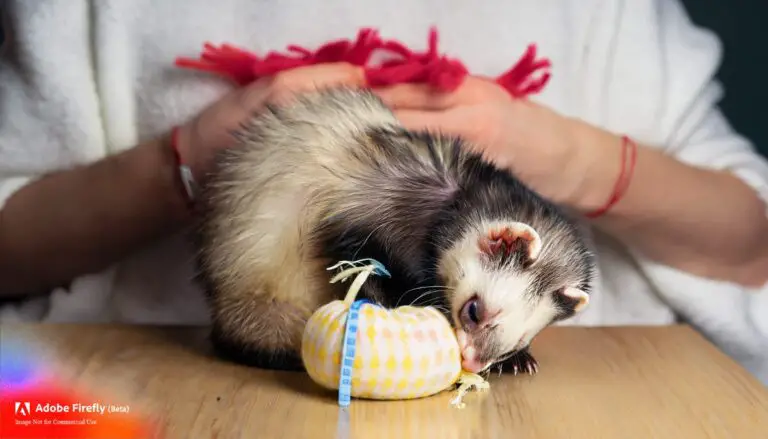
Are you considering getting a ferret as a pet? Well, let me tell you, these little creatures are full of energy and curiosity! But before you bring one home, it’s important to make sure your living space is ferret-proofed. Trust me, I learned this the hard way when my mischievous ferret, Gizmo, turned my house into his personal playground. In this article, I’ll share some essential tips on how to ferret-proof your home, so you can create a safe and secure environment for your furry friend. Let’s dive in and ensure your home is ready for the arrival of your new ferret companion!
Assessing Potential Dangers
When it comes to ferret-proofing your home, one of the first steps you need to take is assessing potential dangers. Ferrets are curious creatures and can easily get themselves into trouble if they come across hazards in your house. As a responsible ferret owner, it’s crucial to identify and eliminate any risks that could harm your furry friend. Here are a few things I did to assess potential dangers in my own home:
- Secure Loose Wires: Ferrets are known for their love of chewing, and electrical cords are no exception. To prevent your ferret from getting electrocuted or causing a fire, it’s important to secure any loose wires by using cable ties or cord covers. Tuck them away behind furniture or use cord concealers to keep them out of your ferret’s reach.
- Remove Toxic Plants: Many common houseplants are toxic to ferrets if ingested. Take a good look around your home and identify any plants that could pose a danger. Examples of common toxic plants include lilies, azaleas, and dieffenbachia. Remove these plants from areas accessible to your ferret, or better yet, opt for pet-friendly plants instead.
- Check for Small Openings: Ferrets have a knack for squeezing into tight spaces. Check your home for any small openings where your furry friend could get stuck or escape. This could include gaps behind appliances, ventilation openings, or loose floorboards. Seal off these areas or use baby gates to restrict access.
- Secure Cabinets and Drawers: Ferrets are expert explorers and can quickly learn how to open cabinets and drawers. Ensure that any cabinets or drawers containing hazardous substances, such as cleaning products or medications, are securely closed and off-limits to your ferret. Consider using child-proof locks or cabinet straps for added security.
By assessing potential dangers in your home, you are taking proactive steps to create a safe and secure environment for your ferret. Remember, it’s always better to be proactive and prevent accidents rather than dealing with the consequences later on.
Stay tuned for the next section, where I’ll provide more tips on how to ferret-proof your home and ensure your furry friend’s well-being.
Securing Doors and Windows
When it comes to ferret proofing your home, it’s important not to overlook the doors and windows. Ferrets are notorious escape artists and can easily slip through even the smallest openings. Here are some tips to help you secure your doors and windows:
- Install secure screens: Make sure all windows and doors have sturdy screens in place. This will not only keep your ferret from escaping but also prevent other animals from entering your home.
- Use door sweeps: Ferrets have a knack for squeezing through tight spaces. To prevent them from slipping through the gap under your doors, consider installing door sweeps. These are essentially strips of material that create a barrier at the bottom of the door.
- Secure sliding doors: Sliding doors can pose a challenge when it comes to keeping your ferret inside. Consider using a barrier, such as a baby gate or a collapsible pet gate, to block off the sliding door area when it’s not in use.
- Inspect for gaps: Carefully inspect all doors and windows for any gaps or cracks where your ferret could potentially slip through. Seal any openings with weatherstripping or caulk to ensure a tight seal.
- Use window locks: Window locks are a great way to prevent your furry friend from pushing open a window and making a daring escape. Make sure all windows have a secure lock in place.
Remember, ferrets are incredibly curious and agile creatures. It’s important to be diligent in checking and reinforcing the security of your doors and windows to keep your mischievous friend safe and sound.
No conclusion paragraph or sentence.
Covering Holes and Openings
When it comes to ferret-proofing your home, it’s crucial to pay attention to any holes or openings that your furry friend might be able to squeeze through. Ferrets have a knack for exploring, and they can fit into surprisingly small spaces. It’s amazing how determined they can be when they want to get somewhere!
To prevent your ferret from getting stuck or escaping, ensure that all small openings are properly covered. Here are a few tips to help you with this:
- Inspect for small openings: Take a thorough look around your home for any small openings that could provide an escape route for your little Houdini. Check under cabinets, behind furniture, and in corners to ensure there are no hidden openings that could jeopardize your ferret’s safety.
- Cover gaps: Use childproof gates or pet gates to cover openings in doorways or staircases. These gates are designed to keep small children and pets contained, and they work perfectly for ferrets as well. Make sure the gates are tall enough to prevent your ferret from climbing over them.
- Seal off crawl spaces: If you have crawl spaces in your home, it’s essential to secure them. Use wire mesh or heavy-duty fabric to block off any openings that your ferret could squeeze through. It’s better to be safe than sorry!
- Secure vents: Ferrets can easily maneuver their way through small vents, so it’s important to cover them with ferret-proof mesh. This will prevent your little explorer from venturing into restricted areas like the ductwork.
By taking these measures, you can ensure that your home is a safe and secure environment for your ferret. Remember, it’s all about being proactive and addressing any potential hazards before they become a problem. With a little bit of effort and attention to detail, you can create a space where your ferret can explore and play without any worries.
Now that we’ve covered the importance of covering holes and openings, let’s move on to the next section: “Securing Cabinets and Drawers”.
Eliminating Toxic Plants
When it comes to ferret-proofing your home, it’s important to consider not only physical hazards but also potential dangers that may be lurking in your houseplants. Many common household plants can be toxic to ferrets if ingested, so it’s crucial to eliminate these plants from their reach.
During my own experience of ferret-proofing my home, I quickly realized the importance of assessing the plants in my house. I discovered that some of the plants I had were potentially harmful to my mischievous little friend. It was a wake-up call for me to take immediate action.
To ensure the safety of your ferret, it’s essential to identify and remove any toxic plants from your home. Some common plants that are toxic to ferrets include:
- Sago palm
- Asparagus fern
- Philodendron
- Pothos
- Aloe vera
- Peace lily
If you’re unsure whether a certain plant is toxic, it’s best to research or consult with a veterinarian who is knowledgeable about ferret care. They can provide you with specific information about plants that pose a risk to your furry friend.
To eliminate the threat of toxic plants, here are some steps you can take:
- Remove: If you have any known toxic plants in your home, remove them immediately. This means taking them out of reach of your ferret or, if necessary, getting rid of them altogether.
- Replace: Consider replacing toxic plants with safe alternatives that are non-toxic to ferrets. This way, you can still enjoy the beauty of indoor greenery without putting your furry friend at risk.
- Educate: If you have friends or family members who also have ferrets or small pets, educate them about the potential dangers of toxic plants. It’s important for everyone to be aware and take the necessary precautions.
By eliminating toxic plants from your home, you can create a safer environment for your ferret. Remember, prevention is key when it comes to ferret-proofing, and being proactive in identifying and removing potential hazards will go a long way in ensuring the well-being of your furry friend.
Organizing Electrical Cords
When I first brought my ferret home, one of the things I quickly realized was how much he loved to chew on anything he could get his paws on. Electrical cords were no exception. Not only is this behavior dangerous for my ferret, but it also poses a serious risk of electrical shock or fire. As a responsible ferret owner, I had to find a way to organize and secure all electrical cords in my home. Here are some tips I found helpful:
- Hide or Tuck Away Cords: The easiest way to prevent your ferret from chewing on electrical cords is to make them less accessible. I began by rerouting cords behind furniture or using cord concealers to hide them along the baseboards. This not only keeps them out of my ferret’s reach, but it also eliminates the temptation altogether.
- Secure Cords with Cable Clips or Ties: Another effective method is to use cable clips or ties to keep cords neatly organized and off the ground. These clips can be attached to walls or furniture and allow you to bundle and route cords in a safe and organized manner. I found that this not only keeps cords out of my ferret’s path but also prevents them from tangling or creating trip hazards.
- Cover Cords with Cord Covers: To further protect electrical cords from nibbling ferrets, I invested in cord covers. These covers are specifically designed to enclose cords, making them less accessible and appealing to curious pets. Cord covers are available in various materials, such as plastic or fabric, and can be easily attached along the length of the cord using adhesive or Velcro.
- Use Cord Shorteners: When dealing with excessively long cords, I discovered that using cord shorteners was a great solution. Cord shorteners allow you to adjust the length of the cords to better suit your needs. By eliminating the excess cord, you can minimize the risk of your ferret getting tangled or chewing on the cords.
Conclusion
Creating a safe and secure environment for your ferret is crucial to ensuring their well-being and preventing any potential accidents or escapes. Through my personal experience, I have learned the importance of ferret-proofing your home before bringing a ferret as a pet.
By following the tips provided in this article, such as securing loose wires, removing toxic plants, checking for small openings, and securing cabinets and drawers, you can minimize the risk of your ferret getting into trouble or harm.
Remember to be proactive in assessing and reinforcing the security of your doors and windows to prevent your ferret from escaping. Installing secure screens, using door sweeps, securing sliding doors, inspecting for gaps, and using window locks are all effective measures to keep your ferret safe.
Covering holes and openings in your home, such as small openings, gaps, crawl spaces, and vents, is essential to prevent your ferret from escaping or getting stuck.
Additionally, eliminating toxic plants from your home and organizing and securing electrical cords are crucial steps to ensure your ferret’s safety.
By implementing these measures, you can create a safe and secure environment for your ferret, allowing them to explore and play without any worries.






